Tank Transformer vs. Dry-Type Transformer: Which is Right for Your Application?
Are you struggling to choose between tank and dry-type transformers? You’re not alone in this dilemma.
The choice between tank and dry-type transformers depends on factors like efficiency, size, environmental impact, safety, and cost. Tank transformers are often more efficient and can handle higher voltages, while dry-type transformers are safer in fire-prone areas and require less maintenance.

I’ve spent years working with both types of transformers, and I can tell you that making the right choice is crucial for your project’s success. Let’s dive into the details to help you make an informed decision.
What Are Tank and Dry-Type Transformers: A Quick Introduction for Decision Makers?
Confused about the basics of tank and dry-type transformers? Let’s clear that up right now.
Tank transformers use oil for insulation and cooling, while dry-type transformers use air and solid insulation. Tank transformers are typically used for higher voltages and outdoor applications, whereas dry-type transformers are common in indoor and fire-sensitive areas.
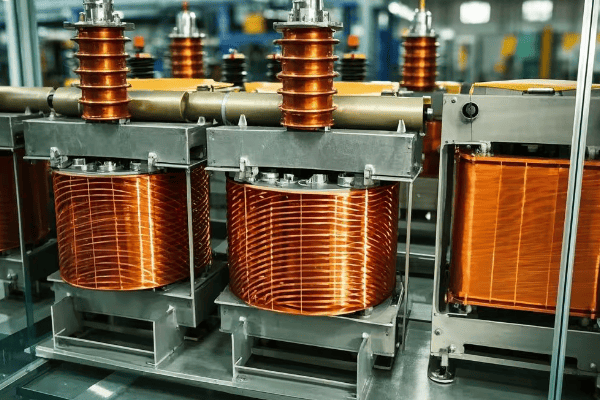
In my years of experience, I’ve seen how crucial understanding these basics is for making the right choice. Here’s a deeper look:
Key Characteristics of Tank Transformers
- Insulation: Uses mineral oil or synthetic fluids
- Cooling: Oil serves as both insulator and coolant
- Typical Applications: Outdoor substations, large industrial settings
- Voltage Range: Can handle very high voltages (up to 765 kV)
- Size: Generally larger and heavier
Key Characteristics of Dry-Type Transformers
- Insulation: Uses air and solid materials (epoxy resin, silicone)
- Cooling: Air-cooled, sometimes with fans
- Typical Applications: Indoor settings, commercial buildings, hospitals
- Voltage Range: Usually up to 35 kV
- Size: Generally smaller and lighter
Let’s compare them side by side:
| Feature | Tank Transformer | Dry-Type Transformer |
|---|---|---|
| Insulation | Oil | Air and solid materials |
| Cooling | Oil-cooled | Air-cooled |
| Typical Location | Outdoor | Indoor |
| Voltage Range | Up to 765 kV | Up to 35 kV |
| Fire Risk | Higher | Lower |
| Maintenance | More complex | Simpler |
I remember a project where we initially specified a tank transformer for a new hospital wing. After considering the fire safety regulations and indoor location, we switched to a dry-type transformer. It was a crucial decision that saved us from potential compliance issues down the line.
Factors to Consider When Choosing
- Location: Indoor or outdoor installation?
- Voltage Requirements: What voltage levels are you working with?
- Load Profile: Continuous heavy loads or intermittent use?
- Environmental Concerns: Is oil leakage a significant risk?
- Fire Safety: Are you dealing with a fire-sensitive area?
- Maintenance Capabilities: Do you have the resources for oil maintenance?
- Noise Considerations: Is the transformer located near occupied areas?
- Budget: Initial cost vs. long-term operational expenses
Understanding these factors is crucial. In my experience, the wrong choice can lead to increased costs, safety risks, and operational inefficiencies. I’ve seen cases where companies had to replace transformers within a few years due to overlooking key factors like location constraints or load growth.
Remember, while tank transformers have been the traditional choice for many high-power applications, advancements in dry-type technology are narrowing the gap. It’s not just about what works now, but what will serve you best in the long run.
Efficiency Comparison: Do Tank Transformers Outperform Dry-Type in Energy Savings?
Worried about energy bills? The efficiency of your transformer can make a big difference.
Generally, tank transformers are more efficient than dry-type, especially at higher ratings. However, recent advancements in dry-type technology have narrowed this gap, making the efficiency comparison more nuanced.
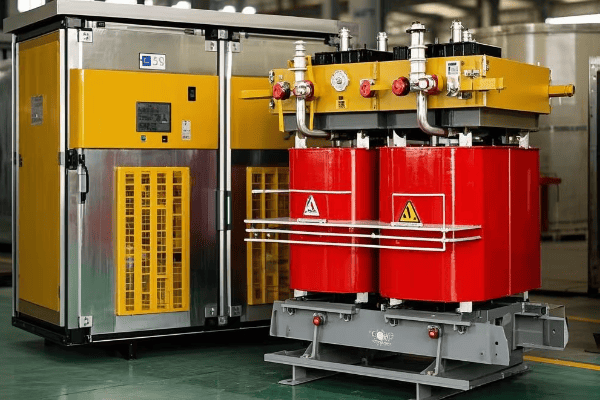
I’ve spent countless hours analyzing transformer efficiencies, and I can tell you it’s not always a straightforward comparison. Let’s break it down:
Understanding Transformer Efficiency
- No-Load Losses: Occur in the core, present even when the transformer is energized but not supplying load
- Load Losses: Occur in the windings, increase with the square of the load current
- Total Losses: Sum of no-load and load losses
Comparing Tank and Dry-Type Efficiencies
| Aspect | Tank Transformer | Dry-Type Transformer |
|---|---|---|
| No-Load Losses | Generally lower | Slightly higher |
| Load Losses | Lower at high loads | Competitive at low to medium loads |
| Cooling Efficiency | More efficient due to oil | Less efficient, relies on air |
| Efficiency at High Ratings | Superior | Good, but typically lower |
| Efficiency at Low Ratings | Comparable to dry-type | Comparable to tank |
In my experience, the efficiency advantage of tank transformers becomes more pronounced as the size and voltage rating increase. For example, I once worked on a project where replacing a 10 MVA dry-type transformer with a tank transformer of the same rating resulted in a 0.5% efficiency improvement. While that might not sound like much, it translated to significant energy savings over time.
Factors Influencing Efficiency
- Core Material: High-grade silicon steel or amorphous metals can significantly reduce core losses
- Winding Design: Optimized winding layouts can reduce copper losses
- Cooling System: Efficient cooling reduces overall losses
- Load Profile: Efficiency varies with load, so matching the transformer to the expected load profile is crucial
- Ambient Temperature: High temperatures can affect efficiency, especially in dry-type transformers
Recent Advancements
Dry-type transformers have seen significant improvements in recent years:
- Use of advanced core materials like amorphous metals
- Improved winding designs and insulation systems
- Better cooling techniques, including the use of cast coil technology
These advancements have made dry-type transformers more competitive in terms of efficiency, especially in the lower to medium power ranges.
Making the Right Choice for Efficiency
When considering efficiency:
- Analyze Your Load Profile: A transformer’s efficiency varies with load. Match the transformer type to your typical operating conditions.
- Consider Total Cost of Ownership: Higher efficiency often means higher upfront costs but lower operating costs.
- Look at Lifecycle Efficiency: Consider how efficiency might degrade over time for each type.
- Check Regulatory Requirements: Some regions have minimum efficiency standards that may influence your choice.
In my years of consulting, I’ve seen cases where the slightly lower efficiency of a dry-type transformer was offset by its lower maintenance costs and better suitability for the installation environment. It’s not always about choosing the most efficient option on paper, but rather the one that offers the best overall performance in your specific situation.
Remember, while tank transformers often have an edge in efficiency, especially at higher ratings, the best choice depends on a holistic view of your application, including factors beyond just efficiency.
Size and Weight: How Space Requirements Differ Between Tank and Dry-Type Transformers
Struggling with limited space for your transformer installation? The size difference between tank and dry-type transformers could be crucial.
Tank transformers are generally larger and heavier due to their oil-filled design, while dry-type transformers are more compact and lighter. This size difference can significantly impact installation options and costs.
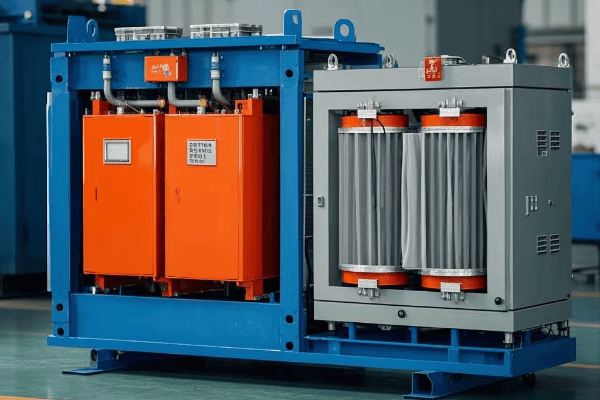
In my years of designing transformer installations, I’ve seen how size and weight can make or break a project. Let’s dive into the details:
Comparing Dimensions and Weight
| Aspect | Tank Transformer | Dry-Type Transformer |
|---|---|---|
| Footprint | Larger | Smaller |
| Height | Generally taller | Usually shorter |
| Weight | Heavier | Lighter |
| Space for Cooling | Needs more | Needs less |
| Containment Requirements | Oil containment needed | No containment needed |
I remember a project where we had to retrofit a transformer in an old urban substation. The limited space and difficulty in transporting a large tank transformer led us to choose a dry-type option, saving both space and installation headaches.
Factors Influencing Size and Weight
-
Insulation Medium:
- Tank: Oil adds significant weight and requires space for expansion
- Dry-Type: Air and solid insulation are lighter and more compact
-
Cooling System:
- Tank: Radiators and oil pumps add to size
- Dry-Type: Air cooling or fans are more compact
-
Voltage Rating:
- Higher voltages generally require larger transformers for both types
-
Power Rating:
- Higher power ratings increase size and weight for both types
-
Design Efficiency:
- More efficient designs can sometimes be smaller due to reduced heat generation
Space Considerations in Different Settings
-
Indoor Installations:
- Dry-type transformers are often preferred due to their compact size and reduced fire risk
- Tank transformers may require special rooms with oil containment
-
Outdoor Substations:
- Tank transformers are common, with space for oil containment and cooling systems
- Dry-type transformers can be used but may need weather protection
-
Rooftop Installations:
- Dry-type transformers are often chosen due to their lighter weight
- Tank transformers may require structural reinforcements
-
Mobile or Temporary Installations:
- Dry-type transformers are easier to transport and set up quickly
-
Underground Installations:
- Dry-type transformers are preferred due to reduced fire and environmental risks
Impact on Installation and Maintenance
-
Transportation:
- Tank transformers often require specialized transport due to weight
- Dry-type transformers are easier to move and position
-
Foundation Requirements:
- Tank transformers need stronger foundations
- Dry-type transformers have less stringent foundation needs
-
Access for Maintenance:
- Tank transformers need space for oil handling equipment
- Dry-type transformers require less clearance for maintenance
In my experience, the size and weight differences between tank and dry-type transformers can have cascading effects on project costs and timelines. I’ve seen cases where the choice of a compact dry-type transformer allowed for a simpler, faster installation process, saving both time and money.
However, it’s not always about choosing the smallest option. In one industrial project, we opted for a larger tank transformer because its higher efficiency and better overload capacity outweighed the space constraints.
When considering size and weight:
- Assess your available space carefully
- Consider future expansion needs
- Factor in installation and maintenance access
- Don’t forget about ancillary equipment like cooling systems and containment structures
Remember, the right choice balances space constraints with performance needs and long-term operational considerations.
Environmental Impact: Oil-Filled vs. Air-Cooled Transformer Technologies
Concerned about the environmental footprint of your transformer choice? You’re not alone in this eco-conscious era.
Tank transformers pose potential environmental risks due to oil leaks but are often more energy-efficient. Dry-type transformers eliminate oil-related environmental concerns but may have a larger carbon footprint due to lower efficiency in some cases.
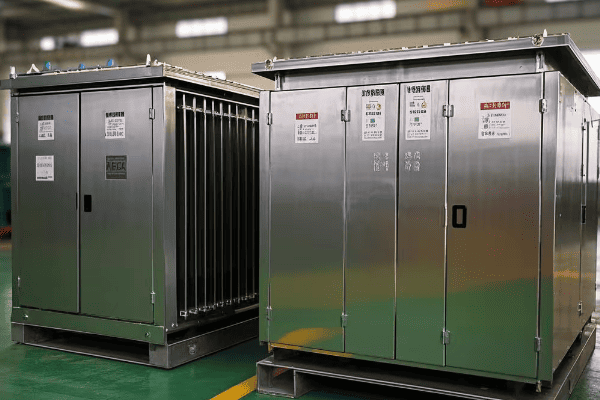
Throughout my career, I’ve seen environmental considerations become increasingly important in transformer selection. Let’s break down the environmental impacts:
Environmental Aspects of Tank Transformers
-
Oil-Related Risks:
- Potential for oil leaks and spills
- Risk of soil and water contamination
-
Energy Efficiency:
- Generally more efficient, especially at higher ratings
- Lower energy losses can mean a smaller carbon footprint over time
-
End-of-Life Considerations:
- Oil must be properly disposed of or recycled
- Metal components are recyclable
-
PCB Legacy:
- Older transformers may contain PCBs, requiring special handling
Environmental Aspects of Dry-Type Transformers
-
No Oil-Related Risks:
- Eliminates the risk of oil leaks and spills
- Safer for environmentally sensitive areas
-
Energy Efficiency:
- Typically less efficient than tank transformers, especially at higher ratings
- Higher losses can lead to increased energy consumption
-
End-of-Life Considerations:
- Easier to recycle with no oil to dispose of
- Some insulation materials may require special handling
-
Material Use:
- May use more copper or aluminum due to less efficient cooling
Let’s compare these aspects:
| Aspect | Tank Transformer | Dry-Type Transformer |
|---|---|---|
| Oil Spill Risk | High | None |
| Energy Efficiency | Higher | Lower (generally) |
| Recyclability | Good, but oil complicates | Excellent |
| Fire Risk | Higher | Lower |
| Material Usage | Less copper/aluminum | More copper/aluminum |
I recall a project near a protected wetland where the environmental risk of an oil spill was deemed too high. We opted for a dry-type transformer despite its slightly lower efficiency. The peace of mind and regulatory compliance were worth the trade-off.
Mitigating Environmental Impacts
For Tank Transformers:
- Use biodegradable oils
- Implement robust containment systems
- Regular maintenance to prevent leaks
- Efficient designs to minimize losses
For Dry-Type Transformers:
- Use high-efficiency designs to minimize energy losses
- Choose environmentally friendly insulation materials
- Implement effective cooling systems to improve efficiency
Lifecycle Environmental Impact
When assessing environmental impact, consider the entire lifecycle:
- Manufacturing: Both types require resource extraction and energy-intensive production
- Operation: Energy efficiency over the operational life is crucial
- Maintenance: Less maintenance for dry-type can mean fewer resources used over time
- End-of-Life: Proper recycling and disposal are important for both types
In my experience, the best environmental choice often depends on the specific application and location. For instance, in a data center project, we chose high-efficiency dry-type transformers. The slightly lower efficiency was offset by the reduced fire risk and cooling needs, which aligned with the facility’s overall energy strategy.
Regulatory Considerations
Environmental regulations are becoming stricter:
- Some areas require oil containment systems for tank transformers
- Energy efficiency standards are pushing both types to improve
- PCB-containing transformers are being phased out globally
When making your choice, consider:
- Local environmental regulations
- Your organization’s sustainability goals
- The specific environmental risks of your installation site
- The long-term energy efficiency and its impact on carbon footprint
Remember, the most environmentally friendly transformer is the one that best fits your specific needs while minimizing overall environmental impact throughout its lifecycle.
Fire Safety Considerations: Why Dry-Type Transformers Might Be Preferred in Some Settings?
Worried about fire risks in your transformer installation? You should be – it’s a critical safety concern.
Dry-type transformers are often preferred in fire-sensitive areas due to their lower fire risk. They don’t use flammable oil, making them safer for indoor installations, densely populated areas, or locations with strict fire safety regulations.

In my years of working on transformer installations, I’ve seen fire safety become an increasingly crucial factor in decision-making. Let’s dive into the details:
Fire Safety Aspects of Tank Transformers
-
**Oil as
-
Oil as a Fire Hazard:
- Mineral oil is flammable
- Oil can ignite if there’s an electrical fault
-
Containment Measures:
- Require oil containment systems
- May need fire walls in some installations
-
Fire Suppression:
- Often require dedicated fire suppression systems
- Water-based systems can be problematic with oil
-
Smoke and Toxic Fumes:
- Burning oil can produce thick smoke and toxic fumes
Fire Safety Aspects of Dry-Type Transformers
-
Non-flammable Materials:
- No oil means reduced fire risk
- Solid insulation materials are typically fire-resistant
-
Self-Extinguishing Properties:
- Many dry-type transformers use self-extinguishing materials
-
Reduced Need for Containment:
- No oil means no need for complex containment systems
-
Simpler Fire Suppression:
- Standard fire suppression systems can be used
- Less risk of spreading fire through liquid
Let’s compare these aspects:
| Aspect | Tank Transformer | Dry-Type Transformer |
|---|---|---|
| Flammable Materials | Yes (oil) | No |
| Fire Risk | Higher | Lower |
| Containment Needs | Extensive | Minimal |
| Smoke Production | High | Low |
| Suitable for Indoor Use | Limited | Widely used |
I remember a project in a high-rise building where the fire marshal initially rejected our plan for a tank transformer in the basement. We switched to a dry-type transformer, which not only met fire code requirements but also simplified the overall installation process.
Key Considerations for Fire Safety
-
Location:
- Indoor vs. outdoor installation
- Proximity to occupied areas
-
Building Codes and Regulations:
- Local fire safety standards
- Insurance requirements
-
Industry-Specific Needs:
- Hospitals, data centers, and schools often prefer dry-type
-
Emergency Response:
- Ease of access for firefighters
- Compatibility with building fire systems
Fire Safety Measures for Tank Transformers
If you must use a tank transformer in a sensitive area:
- Use less flammable fluids (e.g., silicone or vegetable-based oils)
- Install robust fire detection and suppression systems
- Implement proper containment and barrier systems
- Ensure adequate ventilation to disperse heat and fumes
Advantages of Dry-Type in Fire-Sensitive Areas
-
Hospitals and Healthcare Facilities:
- Reduced evacuation risks
- Continuity of critical services
-
High-Rise Buildings:
- Easier compliance with building codes
- Reduced risk to occupants
-
Educational Institutions:
- Safer for densely populated areas
- Peace of mind for administrators and parents
-
Data Centers:
- Protection of critical infrastructure
- Reduced risk of data loss due to fire
In my experience, the choice between tank and dry-type transformers often comes down to fire safety in sensitive environments. I’ve seen cases where the slightly higher cost of a dry-type transformer was easily justified by the reduced fire risk and simplified safety systems.
For instance, in a recent data center project, we chose dry-type transformers despite their slightly lower efficiency. The decision was driven by the critical nature of the facility and the potential catastrophic impact of a fire. The peace of mind and reduced insurance premiums made it a clear choice.
When considering fire safety:
- Assess your environment’s specific risks
- Consult with local fire authorities
- Consider the total cost of fire safety measures, not just the transformer itself
- Think about future changes in building use or regulations
Remember, while dry-type transformers have a clear advantage in fire safety, modern tank transformers with advanced safety features can also be suitable in many applications. The key is to carefully evaluate your specific needs and risks.
Maintenance Requirements: Tank vs. Dry-Type Transformers – Which Costs More Long-Term?
Worried about ongoing maintenance costs? You’re right to consider this crucial factor.
Tank transformers generally require more frequent and complex maintenance due to oil monitoring and handling. Dry-type transformers, with their simpler design, typically have lower maintenance needs and costs over their lifetime.
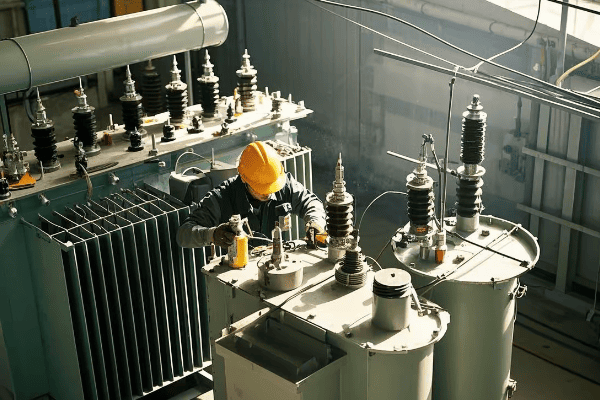
In my years of managing transformer installations, I’ve seen how maintenance can significantly impact the total cost of ownership. Let’s break down the maintenance aspects:
Maintenance Needs for Tank Transformers
-
Oil Testing and Analysis:
- Regular sampling and testing of insulating oil
- Checking for contaminants, moisture, and dissolved gases
-
Oil Filtration or Replacement:
- Periodic oil filtration to remove impurities
- Occasional complete oil replacement
-
Cooling System Maintenance:
- Checking and maintaining radiators, fans, and pumps
- Ensuring proper oil circulation
-
Gasket and Seal Checks:
- Regular inspection for oil leaks
- Replacement of worn gaskets and seals
-
Bushings and Tap Changers:
- Inspection and maintenance of bushings
- Servicing of on-load tap changers
Maintenance Needs for Dry-Type Transformers
-
Visual Inspections:
- Checking for dust accumulation or signs of overheating
- Inspecting insulation for cracks or damage
-
Cooling System Checks:
- Ensuring proper function of fans (if present)
- Cleaning air passages and vents
-
Electrical Testing:
- Periodic insulation resistance tests
- Power factor testing
-
Tightening Connections:
- Checking and tightening electrical connections
Let’s compare these maintenance aspects:
| Aspect | Tank Transformer | Dry-Type Transformer |
|---|---|---|
| Frequency of Maintenance | Higher | Lower |
| Complexity of Maintenance | More complex | Simpler |
| Specialized Equipment Needed | Yes (for oil handling) | Minimal |
| Risk of Leaks | Yes | No |
| Environmental Considerations | Oil disposal/recycling | Minimal |
I recall a manufacturing plant where we replaced several aging tank transformers with dry-type units. The reduction in maintenance downtime and costs was significant, paying for the higher initial investment within a few years.
Long-Term Cost Considerations
-
Labor Costs:
- Tank transformers often require specialized technicians
- Dry-type maintenance can often be done by in-house staff
-
Consumables and Replacements:
- Oil and filtration costs for tank transformers
- Fewer consumables for dry-type transformers
-
Downtime Costs:
- Tank transformers may require longer outages for maintenance
- Dry-type maintenance is typically quicker
-
Environmental Compliance:
- Costs associated with oil handling and disposal for tank transformers
- Minimal environmental compliance costs for dry-type
-
Lifecycle Considerations:
- Properly maintained tank transformers can have a longer lifespan
- Dry-type transformers may need replacement sooner but with less maintenance
Factors Influencing Maintenance Needs
-
Operating Environment:
- Harsh conditions increase maintenance for both types
- Dry-type more sensitive to dusty or corrosive environments
-
Load Profile:
- Heavy or fluctuating loads can increase maintenance needs
- Overloading impacts both types but can be more critical for dry-type
-
Age of the Transformer:
- Older units typically require more frequent maintenance
- End-of-life considerations differ between types
In my experience, the maintenance advantage of dry-type transformers is most pronounced in clean, indoor environments with stable loads. For instance, in a recent data center project, we chose dry-type transformers specifically for their lower maintenance requirements, which aligned well with the facility’s high uptime demands.
However, it’s not always straightforward. I’ve seen cases where well-maintained tank transformers in outdoor substations have operated reliably for decades with scheduled maintenance, outperforming dry-type units in terms of longevity.
When evaluating maintenance costs:
- Consider your available maintenance resources and expertise
- Factor in the criticality of the application and acceptable downtime
- Look at the total cost of ownership, not just routine maintenance
- Consider future regulations that might affect maintenance practices
Remember, while dry-type transformers generally offer lower maintenance costs, the best choice depends on your specific operational context, environment, and long-term strategy.
Conclusion
Choosing between tank and dry-type transformers involves weighing various factors including efficiency, size, environmental impact, fire safety, and maintenance needs. Each type has its strengths, and the best choice depends on your specific application, location, and long-term operational goals.
🚀Next steps, you can:
A. Assess your specific application requirements
B. Consult with a transformer specialist for personalized advice
C. Conduct a cost-benefit analysis for your project
D. Review local regulations and safety standards
E. Consider future expansion and technology trends
F. Explore case studies of similar installations
Free CHBEB Transformer Catalog Download
Get the full range of CHBEB transformers in one catalog.
Includes oil-immersed, dry-type, pad-mounted, and custom solutions.
Quick Message
Request A free quote
We'd like to work with you
- +86 15558785111
- [email protected]
- +86 15558785111
What We Do
CHINA BEI ER BIAN (CHBEB) GROUP, with 218 million in registered capital, originated from Beijing Beierbian Transformer Group. Headquartered in Beijing for R&D, it operates major production bases in Nanjing and Yueqing, producing high-quality products.
Latest Product
address
BeiJing
No 3,RongJing East Road,BeiJing Economic Technological Development Area,BeiJing,China
JiangSu
No 7️Xiangfeng Road,Jiangning,NanJing,JiangSu,China
WenZhou
No.211, Wei 16 Road, Industrial Zone, Yueqing, Wenzhou, Zhejiang, China.
XiangYang Industrial Zone ,YueQing,WenZhou,ZheJiang,China
contact us
- [email protected]
- +86 13057780111
- +86 13057780111
- +86 15558785111
Copyright © Bei Er Bian Group


